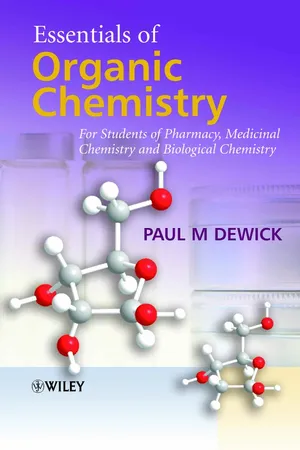Biological Sciences
Carbohydrates
Carbohydrates are organic compounds made up of carbon, hydrogen, and oxygen. They serve as a primary source of energy for living organisms and are essential for various cellular processes. Carbohydrates can be found in foods such as fruits, vegetables, grains, and dairy products, and they play a crucial role in the structure of cells and tissues.
Written by Perlego with AI-assistance
Related key terms
4 Key excerpts on "Carbohydrates"
- eBook - ePub
Essentials of Organic Chemistry
For Students of Pharmacy, Medicinal Chemistry and Biological Chemistry
- Paul M. Dewick(Author)
- 2013(Publication Date)
- Wiley(Publisher)
12
Carbohydrates
12.1 Carbohydrates
Many aspects of the chemistry of Carbohydrates are not specific to this class of compounds, but are merely examples of the simple chemical reactions we have already met. Therefore, against usual practice, we have not attempted a full treatment of carbohydrate chemistry and biochemistry in this chapter. We want to avoid giving the impression that the reactions described here are something special to this group of compounds. Instead, we have deliberately used Carbohydrates as examples of reactions in earlier chapters, and you will find suitable cross-references.Carbohydrates are among the most abundant constituents of plants, animals, and microorganisms. Polymeric Carbohydrates function as important food reserves, and as structural components in cell walls. Animals and most microorganisms are dependent upon the Carbohydrates produced by plants for their very existence. Carbohydrates are the first products formed in photosynthesis, and are the products from which plants synthesize their own food reserves, as well as other chemical constituents. These materials then become the foodstuffs of other organisms. The main pathways of carbohydrate biosynthesis and degradation comprise an important component of intermediary metabolism that is essential for all organisms (Chapter 15).The name carbohydrate was introduced because many of the compounds had the general formulaCx(H2 O)y , and thus appeared to be hydrates of carbon. The terminology is now commonly used in a much broader sense to denote polyhydroxy aldehydes and ketones, and their derivatives. Sugars or saccharides are other terms used in a rather broad sense to cover carbohydrate materials. Though these words link directly to compounds with sweetening properties, application of the terms extends considerably beyond this. A monosaccharide is a carbohydrate usually in the range C3 –C9, whereas oligosaccharide covers small polymers comprised of 2–10 monosaccharide units. The term polysaccharide - eBook - ePub
- Raymond S. Ochs(Author)
- 2021(Publication Date)
- CRC Press(Publisher)
4 CarbohydratesCarbohydrates are most commonly encountered as the sweetener sucrose and as starch, the nutrient of bread and pasta. The Carbohydrates are literally hydrates of carbon, having the empirical formula (CH2 O)n . Because they possess both hydroxyl and carbonyl groups, they are a step up in complexity from lipids. Unlike lipids, Carbohydrates are generally very soluble in water. The Latin word for sugar is saccharide; this is commonly used in the term polysaccharides. Sugars are nutrients for both animals and plants. Animals use sugars for rapid (i.e., minute-to-minute) energy production and lipids for long-term storage. Plants use sugars for energy exclusively, except at the seed stage. Sugars have greater weight than lipids, making them less suitable for long-term energy storage for organisms with mobile lifestyles (i.e., animals and seeds). The reason for the greater mass of sugars is two-fold. Sugars contain more oxygen atoms and are thus denser than lipids. Sugars also associate with water (through hydrogen bonding), further increasing their weight.Aside from providing energy, sugars have a wide variety of roles once they are chemically modified, such as cell–cell recognition and signaling. The specificity of blood group types derives from sugars attached to membrane lipids of red blood cells. Proteins secreted from cells are usually covalently linked to sugars. Thus, sugars are integral to biological function. We begin our study of sugars with the simplest ones: the monosaccharides.4.1 Monosaccharides
Monosaccharides have a single carbonyl group, which occurs at the first or second carbon atom. All remaining carbons have an attached hydroxyl group. There are two classes of monosaccharides: aldoses and ketoses. Aldoses (aldehydes) have the carbonyl at carbon one, whereas ketoses (ketones) have the carbonyl at carbon two.The “-ose” suffix (as in aldose and ketose) usually indicates that a compound is a sugar. The general category name for sugars is shown in Table 4.1 , starting with the smallest, the triose - eBook - ePub
- Hongbo Zeng(Author)
- 2013(Publication Date)
- Wiley(Publisher)
13 Carbohydrates AND THEIR ROLES IN BIOLOGICAL RECOGNITION PROCESSES Keshwaree Babooram and Ravin Narain13.1 INTRODUCTION
Present in all living organisms, and ranging from the simpler and lower molecular weight monosaccharides to the more complex and higher molecular weight polysaccharides, Carbohydrates are one of the most important and structurally diverse classes of biomolecules in nature [1, 2]. In addition to their numerous commonly known roles in living organisms, such as in the provision of energy, the breakdown of fatty acids, and prevention of ketosis, and their use as sweeteners and flavor enhancers, Carbohydrates have been found to play a major role in many biological recognition processes through their interactions with proteins and other biological moieties [3, 4]. These structurally and functionally fascinating molecules are key players in numerous cellular recognition processes such as cell growth regulation, adhesion, differentiation, cellular trafficking, cancer cells metastasis, immune response, and inflammation by bacteria and viruses [2].The aim of this chapter is to present an insight into the essence of Carbohydrates and carbohydrate-based polymers in biological processes. The first part of the chapter will provide an overview of the recent advances in the field of carbohydrate chemistry with emphasis on the different synthesis routes employed in the fabrication of glycopolymers and on the various studies carried out on their potential use in the biomedical field. This part also covers progresses made in the fields of carbohydrate microarrays and carbohydrate-based vaccines to give readers an idea of how these complex molecules have helped and are helping in changing human lives for the better. The next section of this chapter will be dedicated to an overview of the molecular interactions of Carbohydrates in cell recognition, with the main focus being on some of the major techniques currently being used in their identification. - Shilin Chen, Andrew Marston, Hermann Stuppner(Authors)
- 2014(Publication Date)
- Wiley(Publisher)
18 Analysis of Plant Oligo- and PolysaccharidesWolfgang BlaschekDepartment of Pharmaceutical Biology, University of Kiel, Kiel, Germany1 Introduction
Carbohydrates represent the major organic substance on earth. They are mainly built in the process of photosynthesis by cyanobacteria and aquatic and land plants. Carbohydrates are structural elements of nucleic acids (DNA and RNA), some coenzymes (e.g., NAD(P)H and ATP), glycoproteins, and many secondary products (e.g., flavonoid glycosides, anthraquinone glycosides, and cardiac glycosides). Most plants use Carbohydrates, especially the disaccharide sucrose to transport energy (in the phloem). Carbohydrates can bear information in molecular or cellular recognition. The bulk of Carbohydrates in plants, however, are storage polysaccharides (e.g., starch and fructans) or cell wall polysaccharides (e.g., pectins, hemicelluloses, and cellulose) (Nishinari et al., 2007; Fry, 2011).Monosaccharides are the basic structural unit of oligo- and polysaccharides. The most common monosaccharides occurring in oligo- and polysaccharides are arabinose and xylose (pentoses); glucose, galactose, mannose, and fructose (hexoses); rhamnose and fucose (6-deoxy hexoses); and galacturonic acid and glucuronic acid (hexuronic acids).Disaccharides are Carbohydrates in which two monosaccharide units are joined by a glycosidic linkage.Oligosaccharides by definition contain up to 10 monosaccharide residues joined by glycosidic linkages. According to the number of monosaccharide residues, they are trisaccharides, tetrasaccharides, pentasaccharides, and so on and then have a degree of polymerization (DP) of 3, 4, 5, and so on, respectively. Oligosaccharides may be linear, branched, or even cyclic (cyclodextrins). For oligosaccharides, a defined structure can be given.Some examples for common plant di- and oligosaccharides are given in Table 1 .Table 1
Learn about this page
Index pages curate the most relevant extracts from our library of academic textbooks. They’ve been created using an in-house natural language model (NLM), each adding context and meaning to key research topics.



